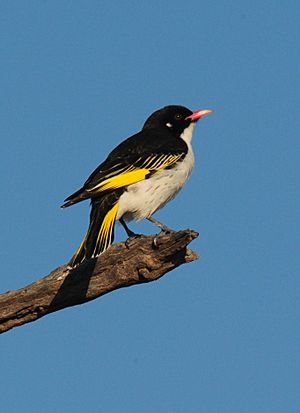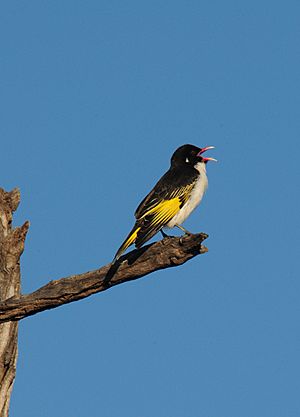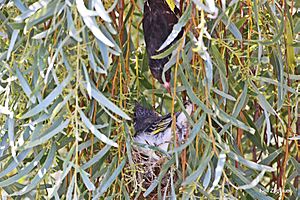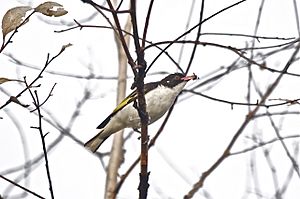Painted honeyeater facts for kids
Quick facts for kids Painted honeyeater |
|
|---|---|
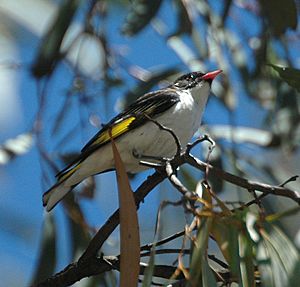 |
|
| Conservation status | |
| Scientific classification | |
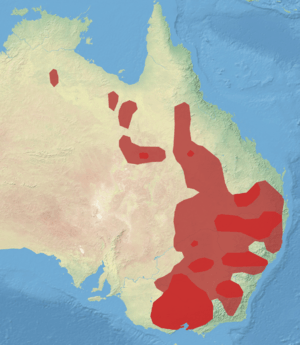 |
|
| Distribution of the painted honeyeater Deeper Red Indicates Breeding Range |
The painted honeyeater (Grantiella picta) is a special type of honeyeater bird. It's the only species in its own unique group, called a monotypic genus. This bird is known for its bright yellow markings and its strong connection to mistletoe plants.
Contents
About the Painted Honeyeater
The painted honeyeater belongs to the Meliphagidae family of birds. It was first described in 1838 by John Gould, who gave it the name Entomophila picta. Later, in 1911, Gregory Macalister Mathews renamed it Grantiella picta. The name Grantiella honors Robert Grant, a collector, and picta is Latin for "painted," referring to the bird's colorful feathers.
Scientists use DNA sequencing to understand how different bird species are related. Studies have shown that the painted honeyeater is linked to other honeyeaters like Plectorhyncha and Xanthotis. This helps us learn more about the history and connections within the honeyeater family.
What it Looks Like
The painted honeyeater is a small bird, usually about 16 cm long and weighing around 20-25 grams. Its tail is about 5.5 cm long, and its beak is about 1.3 cm.
Adult male painted honeyeaters have black feathers on their head and upper body. They have small white spots on the sides of their head. Their chest, belly, and the underside of their tail are white, sometimes with black spots.
The most striking feature is the bright yellow edges on their black wing and tail feathers. They also have a pink beak with a grey tip, grey legs, and reddish-brown eyes.
Female painted honeyeaters are a bit smaller and paler than males. Young birds are even lighter, looking more brown than black, with fainter yellow colors and a grey beak instead of pink.
Where it Lives and its Home
The painted honeyeater lives only in Australia, mainly in the eastern and northern parts. During spring and summer, you can find them in central Victoria, New South Wales, the ACT, and southern Queensland.
In winter, they travel north to places like Cape York Peninsula in Queensland and eastern parts of the Northern Territory. They have also been seen in South Australia.
These birds mostly live in woodlands and forests with Eucalyptus and Acacia trees. Their movements are closely tied to where they can find mistletoe plants, which are a very important food source for them. They migrate north and south depending on when mistletoe berries are available.
Studies show that painted honeyeaters are more common in areas where the natural habitat hasn't been broken up or cleared too much. They also like places with many trees and lots of canopy cover.
The painted honeyeater is a nomadic bird, meaning it moves around a lot, and it can be quite hard to spot. When seen, they are usually in pairs or alone, rarely in large groups.
Important Bird Areas
BirdLife International has listed several places that are important for protecting the painted honeyeater:
- New South Wales
- Binya and Cocoparra
- Capertee Valley
- Goonoo
- Pilliga
- South-west Slopes of NSW
- Queensland
- Victoria
- Warby-Chiltern Box-Ironbark Region
Behavior
Calls and Songs
Painted honeyeaters are known for their distinct call, which sounds like "Georgie," often broken into two notes, like geor-gie or georg-EEE. They can also reverse this call. Males are especially vocal when trying to attract a mate. Both males and females call out when flying during breeding season, especially when leaving or approaching their nest.
Sometimes, birds become quieter once they start nesting, or they might make softer calls if people get too close. They also have an alarm call if they feel threatened, like when eggs are in danger.
Reproduction and Life Cycle
Unlike some honeyeaters that depend on flower nectar, the painted honeyeater's breeding is all about mistletoe berries, especially those from the Amyema plant.
They build nests in various trees, including Eucalyptus species, but they often prefer yarran (Acacia homalophylla) and white cypress-pine (Callitris glaucophylla). These trees often host the grey mistletoe (Amyema quandang).
The breeding season usually runs from October to March. The exact timing depends on how much food is available, which can change with the weather. Having enough food is key for both the adult birds and their young to survive.
Male painted honeyeaters usually arrive at the nesting site a few weeks before the females. Both sexes leave about five months later when mistletoe berries become scarce. Even though berries are available all year, they are most plentiful in warmer months.
The birds time their nesting so they arrive when food is increasing, not decreasing. Nesting near mistletoe helps them save energy because they don't have to fly far to find food. However, nests built right inside mistletoe clumps can sometimes be more easily found by predators.
Mistletoe branches provide a good structure for nests, and the thick leaves help hide them. Mistletoe might also offer a cooler microclimate for the nest during hot weather. The timing of egg-laying, hatching, and when the young birds leave the nest (fledging) all match up with when the berries are most ripe.
Both male and female painted honeyeaters work together to build and shape the nest. This can take several weeks. While the female gathers materials, the male often follows her to protect her from other males. Both parents also share the job of incubating the eggs and caring for the young. Some pairs even try to breed more than once in a season.
Nests and Eggs
Painted honeyeater nests are shaped like a cup. They are made from thin roots, bark, and grass, woven together with spider webs. The nest can be so thin that you might even see through parts of it.
Nests can be built anywhere from a couple of meters to over 15 meters high in trees. They are usually found in the hanging branches of eucalyptus trees or within mistletoe plants.
A female typically lays 2 eggs, but sometimes it can be 1 or 3. The eggs are oval-shaped, about 2 cm long, and pale pink. They have reddish-brown spots, which are darker at the wider end of the egg.
What they Eat
Most honeyeaters eat a mix of nectar, berries, and insects. The painted honeyeater is a frugivore, meaning it mainly eats fruit. It relies heavily on mistletoe plants and their berries. The number of painted honeyeaters in an area often depends on how much mistletoe is available.
They eat berries from at least five different types of Amyema mistletoe. When they eat the berries, they help spread the mistletoe seeds through their droppings. The berries from grey mistletoe (Amyema quandang) are full of carbohydrates, protein, and water, making up a big part of their diet.
When mistletoe berries are not available, painted honeyeaters will eat nectar and insects. They also need insects and nectar to get certain nutrients, like amino acids and protein, that are low in mistletoe fruit.
Protecting the Painted Honeyeater
The painted honeyeater is considered a vulnerable species in several parts of Australia. This means its numbers are decreasing. A major threat is habitat loss, which happens when their homes are cleared or broken up into smaller pieces.
In Australia
The painted honeyeater is not listed as threatened under Australia's main environmental law, the Environment Protection and Biodiversity Conservation Act 1999.
In Different States
- Victoria: Listed as threatened under the Flora and Fauna Guarantee Act (1988). There's a plan to help this species recover. It's also listed as vulnerable on the 2007 advisory list of threatened animals in Victoria.
- New South Wales: Listed as vulnerable under the Threatened Species Conservation Act 1995.
- Australian Capital Territory: Listed as vulnerable under The Nature Conservation Act 1980.
- Queensland: Listed as vulnerable under the Nature Conservation Act 1992.
- Northern Territory: Listed as vulnerable under the Territory Parks and Wildlife Conservation Act 2000.
It's very important to manage areas with lots of mistletoe to help the painted honeyeater. Even though mistletoe is sometimes seen as a pest, it's vital for these birds' breeding success and for keeping many species and biodiversity healthy. Mistletoe provides food and shelter for many animals, including endangered ones.
Protecting the trees that host mistletoe and managing farming practices are key to saving the painted honeyeater's habitat. Areas like the Acacia harpophylla forests in southern Queensland are very important as habitats continue to be destroyed elsewhere.
Efforts to protect other threatened birds like the Regent honeyeater (Xanthomyza phrygia) and the Swift parrot (Lathamus discolor) can also help the painted honeyeater. This shows how important mistletoe is for supporting many bird populations and for overall conservation.
See also
 In Spanish: Mielero pintado para niños
In Spanish: Mielero pintado para niños



